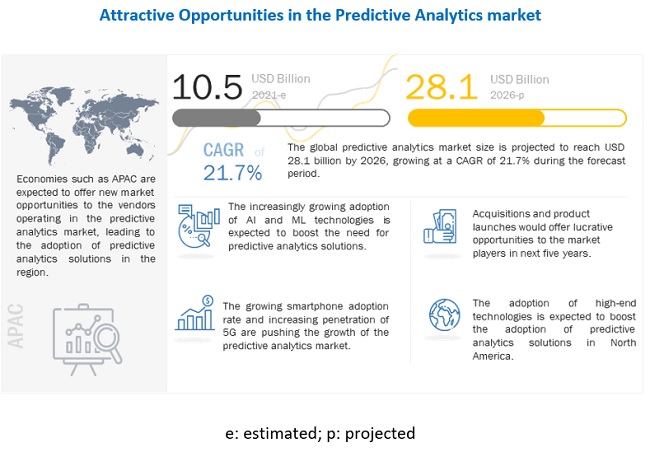Predictive analytics is the practice of using data mining, machine learning, and statistical modeling to analyze current and historical data in order to identify patterns and make predictions about future events. At its core, it aims to go beyond simply describing what has happened to providing a best assessment of what will happen in the future.
According to a study by Markets and Markets, the predictive analytics market size was valued at $10.5 billion in 2021 and is projected to reach $28.1 billion by the end of 2026.
How it works
The process typically involves the following steps:
- Data collection: Relevant data is gathered from various sources such as transactional data, sensor data, social media, and more.
- Data preparation: The raw data is cleaned, formatted, and sampled as needed for the modeling techniques that will be used.
- Statistical modeling: A variety of modeling techniques are employed, such as regression analysis, time series forecasting, decision trees, neural networks, and more. The goal is to train models that can reliably capture patterns and relationships within the data.
- Model validation: Models are tested against historical data to measure their accuracy and predictive power using metrics like R-squared and RMSE.
- Deployment: Once a satisfactory model is selected, it can be operationalized and integrated with other systems to provide predictive scores and insights.
Leveraging this data for growth and strategy
Many industries use this concept of forecasting the future, for instance in marketing (customer profiling, churn reduction), finance (credit risk, fraud detection), and manufacturing (predictive maintenance).
Predictive analytics transforms revenue strategies by enabling marketing to personalize more of the customer experience and boost customer engagement and retention. Here are a few examples of how you can use it in your own marketing:
- Boost marketing effectiveness: Pinpoint top customer segments, refine campaign strategies, and forecast sales impacts, giving you the data to ask for more budget and provide a compelling business case for resources and support.
- Drive informed strategy: Anticipate market trends, forecast product demand, and spot opportunities and risks. Set alerts at different thresholds so you can be immediately aware of outliers in performance of any of your campaigns.
- Improve customer retention: Tailor engagement strategies and proactively address dissatisfaction, reward top customers and increase customer retention in the process.
It's a whole new world
You probably already use some form of predictive analytics in your business strategy: by looking at historical data, you can determine the average growth rate for the whole year, and the monthly average.
Assign a growth coefficient that aligns with this monthly average. Extrapolate the months forward and now you know what your future data looks like if everything stays the same.
Except we know that nothing stays the same. There's always some kind of variable that we can't control, internally (a key person quits) and externally (ThE EcOnOmY).
With advancements in machine learning, data warehouses, and AI, predictive analytics has so much potential to be more than just a "future guesstimate".

AI will change the game, of course
Artificial Intelligence, particularly machine learning, is a key driver propelling the advancement of predictive analytics capabilities.
- Automated model building: AI techniques like AutoML and Neural Architecture Search can automatically explore numerous model types and configurations to find the best predictive model for a given dataset.
- Handling complex datasets: Deep learning models excel at finding patterns and insights from complex, unstructured data types like images, speech, text etc. enabling new predictive use cases.
- Real-time scoring: AI models can be deployed for real-time scoring and predictions at scale, .
- Continuous learning: AI models can continuously ingest new data to refine and improve their predictions over time in a process called online learning.
We know by now that AI is not a silver bullet – yet, at least. Data quality, using the right techniques, managing bias, privacy issues, and maintaining transparency remain key challenges as highlighted in this Harvard Business Review article.
As AI continues advancing, predictive analytics will become ever more widespread, powerful yet accessible - unlocking new frontiers in data-driven decision making across industries and domains.


